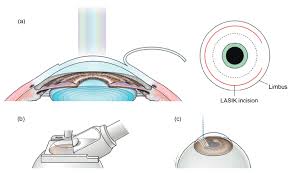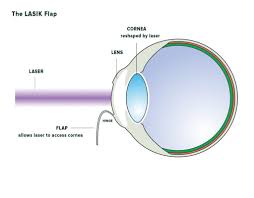Table of Contents
ToggleIf you’re considering LASIK surgery, it’s normal to feel a mixture of excitement and apprehension.
While the prospect of clearer vision is enticing, the idea of having a laser pointed at your eye can understandably seem daunting.
But is LASIK really as scary as it seems?
In this blog, we’ll unravel the mysteries surrounding LASIK, providing you with detailed information to help you make an informed decision.
Understanding LASIK Surgery
What is LASIK?
LASIK, an acronym for Laser-Assisted In Situ Keratomileusis, is a widely recognized surgical procedure aimed at correcting prevalent vision issues, including myopia (nearsightedness), hyperopia (farsightedness), and astigmatism.
It works by reshaping the cornea, the clear front part of the eye, to enable light entering the eye to be properly focused onto the retina for clearer vision.
The Procedure
The LASIK procedure typically involves three main steps:
- Creating a Corneal Flap: A surgeon employs either a microkeratome blade or a femtosecond laser to create a thin, circular flap in the cornea. This flap is then folded back to access the underlying cornea (stroma).
- Reshaping the Cornea with a Laser: An excimer laser is used to remove microscopic amounts of tissue from the cornea to achieve the desired shape and refraction needed for improved vision.
- Repositioning the Flap: The corneal flap is carefully laid back into its original position, where it will naturally adhere without the need for stitches.
The entire process is usually completed within 15 minutes for both eyes, making it a quick and efficient procedure.
Addressing Common Concerns
The Fear of Pain
One of the most prevalent concerns associated with LASIK is the apprehension of experiencing pain. However, the procedure is generally painless. Before the surgery, numbing eye drops are administered to ensure you don’t feel discomfort during the procedure. You might experience some pressure when the corneal flap is created, but it doesn’t last long.
Post-surgery, it’s normal to feel mild discomfort or irritation—akin to having an eyelash in your eye—for the first few hours. Most patients find that this discomfort is manageable with over-the-counter pain relief and subsides quickly.
Fear of Complications
Like any surgical procedure, LASIK does carry some risk, albeit minimal. Complications are infrequent and can typically be managed effectively. The most common concerns include:
- Dry Eyes: Some patients experience temporary dryness post-LASIK. Artificial tears and eye drops prescribed by your surgeon can help alleviate this symptom.
- Night Vision Issues: Some may notice glare or halos around lights, particularly at night. These symptoms typically diminish over time as the eyes heal.
- Flap Complications: Issues with the corneal flap are exceedingly rare and can usually be corrected promptly by your surgeon if they occur.
Selecting a reputable and experienced surgeon significantly reduces the risk of complications. It’s crucial to discuss potential risks with your surgeon during the consultation to understand the specifics related to your individual eye health.
Fear of the Unknown
The unfamiliarity of being in a surgical setting can be intimidating. Nevertheless, understanding what to anticipate can assist in alleviating this apprehension.
During the procedure:
- You’ll Be Awake: You remain awake during the surgery but may receive medication to help you relax.
- The Environment: The operating room is sterile, and you’ll be asked to lie back comfortably. The surgeon will position your head and focus a small device on your eye to keep it open.
- Laser Sounds and Smells: You’ll hear the laser’s clicking sounds and might notice a mild smell similar to burning hair. This is a normal occurrence and is merely the result of the laser reshaping the corneal tissue.
The Benefits of LASIK
Understanding the benefits of LASIK can help outweigh the fears associated with the procedure:
- Immediate Results: Most patients notice improved vision within 24 hours of the surgery.
- Long-Term Vision Correction: LASIK offers a long-term solution for vision correction, reducing or even eliminating the dependence on glasses or contact lenses.
- Quick Recovery: With minimal downtime, most people can return to their normal activities within a day or two.
- Proven Safety and Efficacy: LASIK has been FDA-approved since 1999 and has a high satisfaction rate among patients, making it one of the most researched and proven elective medical procedures available.
Who is a Good Candidate for LASIK?
While LASIK is an excellent option for many individuals, it may not be appropriate for everyone. To assess your candidacy, please consider the following criteria:
- Age: You must be at least 18 years old and have maintained a stable prescription for a minimum of one year.
- Overall Eye Health: Your eyes should be healthy, and free from diseases like glaucoma or cataracts.
- Corneal Thickness: A sufficient corneal thickness is necessary for creating the corneal flap.
- Pregnancy: Pregnant or nursing women should wait, as hormonal changes can affect vision stability.
A comprehensive evaluation by a qualified eye surgeon will help determine your eligibility for the procedure.
Preparing for LASIK Surgery
If you have chosen to proceed with LASIK, thorough preparation is essential for facilitating a seamless process.
- Consultation: Schedule a consultation with a licensed LASIK surgeon who will assess your vision and eye health to ensure you’re a suitable candidate.
- Stop Wearing Contacts: Discontinue wearing contact lenses several weeks before the surgery, as they can alter the shape of your cornea.
- Arrange Transportation: Plan for someone to drive you home after the procedure, as your vision will be temporarily hazy.
- Follow Pre-Op Instructions: Your surgeon will provide specific instructions on eating, drinking, and medication use before surgery.
What to Expect Post-Surgery
The recovery period after LASIK is typically short and straightforward. Here’s what you can expect:
- Vision Improvement: Your vision will begin to improve within a few hours after surgery. It might continue to fluctuate slightly for a few weeks.
- Follow-Up Appointments: It is imperative to attend all scheduled follow-up appointments to monitor your healing process and address any concerns in a timely manner.
- Protect Your Eyes: Please utilize the prescribed eye drops to prevent infection and dryness. Avoid rubbing your eyes, and wear protective eyewear as directed.
- Activity Restrictions: Avoid strenuous activities and swimming for a few weeks to allow your eyes to heal properly.
The Takeaway
While the idea of LASIK can initially seem intimidating, understanding the procedure, potential risks, and benefits is crucial in dispelling fears. With careful research, a thorough discussion with a qualified surgeon, and realistic expectations, many find that LASIK is a life-changing decision that offers the freedom of clear vision.
If you’re contemplating LASIK, don’t hesitate to book a consultation with an experienced eye care professional. They can provide personalized advice and address any lingering concerns, helping you make the best choice for your vision and lifestyle.
Remember, the key to overcoming fear is often knowledge. By equipping yourself with the right information, you can confidently decide whether LASIK is the right step toward achieving your vision goals.













